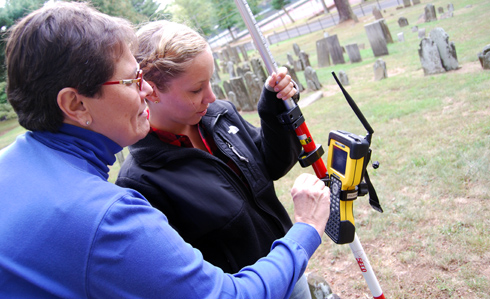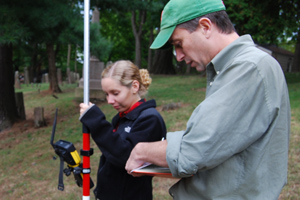Service Learning Class Studies Local Cemetery

On Oct. 10, 1741, Mr. William Bartlit was laid to rest in the Vine/Washington Street Cemetery near Wesleyan University. According to his gravestone, Bartlit was “aged about 70 years” and was “the first interred in this yard.”
“Mr. Bartlit has the oldest marker in this cemetery,” says Elizabeth Milroy, director of the Art History Program and professor of art history and American studies at Wesleyan University. “We would like to find out more about him.”
Milroy, who is teaching the Service Learning Course AMST 205 “The Study
of Material Culture: Marking the Past in Middletown,” is assigning each of her eight students particular grave markers in the cemetery. Students will conduct research on a deceased person, while studying how artifacts can mark the history of space and place within the urban environment of Middletown.

In addition, students will gain a working knowledge of the theoretical approaches that have been applied to material culture studies, as well as practical experience in the physical and contextual analysis of artifacts and cultural landscapes.
On Oct. 2-3, John Hinchman, a lecturer and research specialist in the Architectural Conservation Laboratory of the Historic Preservation Program at the University of Pennsylvania, taught Milroy’s students how to use a “total station” and scanner tool to map the cemetery’s terrain and grave markers. The collected data is imported into engineering software AutoCAD, and as a result, the class will have a detailed and accurate map of the entire cemetery’s physical layout.
“There’s no paper work on this cemetery, so we know no more about who is buried here than what their headstones say,” says Augie DeFrance, president of the Middletown Old Burial Ground Association.
At the end of the semester, Milroy will donate her class’s findings to the association.
“The cemetery is a laboratory. One aim of the course is to engage students with the local community by having them explore Middletown’s rich history,” Milroy says, “At the same time, they learn about the wider challenges of historic preservation in the 21st century.”
Another Wesleyan class, taught by Sarah Croucher, assistant professor of anthropology and archaeology, will conduct research on archaeology materials that date from the same period of Middletown’s history. In the 1970s, several items were excavated from downtown Middletown.
Her class also will examine artifacts discovered in the ‘Beman triangle’ between Vine, Cross and Knowles Streets. Their lab is located in the basement of the old AME Zion Church.

